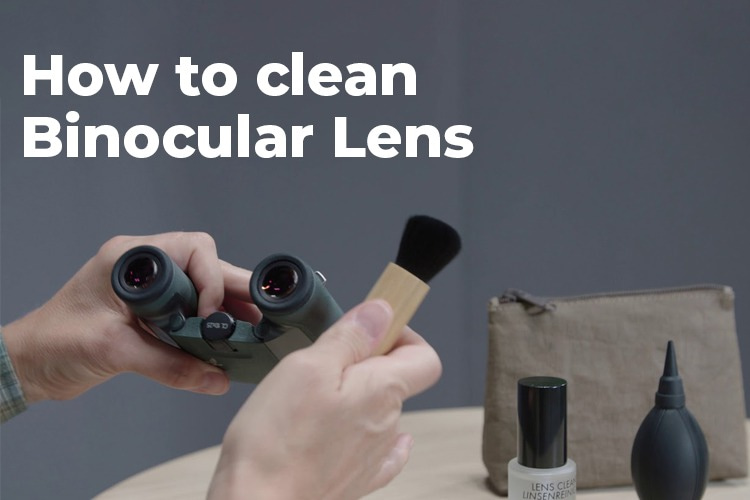A Guide to Clean Binoculars Lenses for Optimal Viewing

Binoculars are very important tools for nature lovers, bird watchers, star gazers and explorers. For having the best experience when viewing, it’s really important to make sure the lenses are kept clean and without any dust, fingerprints, or dirt. Cleaning binoculars lenses might seem like a delicate task, but with the right techniques and tools, anyone can maintain crystal-clear optics. If you have any issues on how to get moisture out of binoculars the solution will be different. Here we will discuss how to clean binoculars lens. Let’s have guidance for the process of cleaning binoculars properly, one step at a time.
How to Clean Binoculars Inside Lens
The inside lens of binoculars are the ones that face your eyes when you look through them. They are also called the eyepieces or the oculars. These lenses can get smudged by your eyelashes, fingerprints, or sweat, which can reduce the brightness and sharpness of the image.
To clean the inside lens of binoculars, you will need the following tools:
- A lens pen or canned air
- A cleaning cotton or microfiber cloth
- A lens cleaning solution, water, or kit
The steps to clean the inside lens of binoculars are as follows:
- Read the manual of your binoculars to see if the manufacturer recommends any specific tools or chemicals for cleaning. Some binoculars have different lens coatings that may react differently to certain solutions. Avoid using any household cleaners, paper products, or clothing items, as they can scratch or damage the lens coatings.
- Hold the binoculars upside down and use a lens pen’s bristles to loosen any light dust or dirt on the lens. Then, use some canned air to blow off the loosened particles. Do not use the microfiber cloth or your breath to remove dust, as this can cause scratches or water spots on the lens.
- Using a cotton swab with water or a cleaning solution, gently wipe away any remaining dirt or smudges on the lens. Do not pour the solution directly onto the lens, as this can seep into the internal components of the binoculars and cause damage. Use a circular motion rather than up and down, as this can leave less impressions on the lens.
- Use a dry microfiber cloth to polish the lens and remove any streaks or residues. Do not rub too hard or too long, as this can also damage the lens coatings. Repeat the process for the other inside lens.
Binocular Lens Cleaning Kit
A binocular lens cleaning kit is a set of tools and chemicals that are designed specifically for cleaning binocular lenses. They usually include a lens pen, a microfiber cloth, a cleaning solution, and sometimes a brush or a blower. A binocular lens cleaning kit can be convenient and effective for maintaining the cleanliness and clarity of your binoculars.
However, not all binocular lens cleaning kits are created equal. Some may contain harsh or low-quality chemicals that can harm your binoculars. Therefore, it is important to choose a reputable and reliable brand that has good reviews and ratings from other users.
How to Clean Binoculars that are Sticky
Sometimes, binoculars can become sticky due to exposure to humidity, moisture, or heat. This can cause the rubber or plastic parts of the binoculars to deteriorate and release a sticky substance that can attract dust and dirt. This can make the binoculars uncomfortable to hold and use, and can also affect the functionality of the focus wheel, the eyecups, or the hinges.
To clean binoculars that are sticky, you will need the following tools:
- A soft cloth or sponge
- A mild soap or detergent
- Warm water
- A dry towel
The steps to clean binoculars that are sticky are as follows:
- Wipe off any loose dust or dirt from the binoculars with a dry cloth or sponge. Do not use any abrasive or sharp objects, as they can scratch or damage the binoculars.
- Mix some mild soap or detergent with warm water in a bowl or a sink. Do not use any harsh or strong chemicals, as they can corrode or discolor the binoculars.
- Dip the cloth or sponge in the soapy water and wring it out. Gently rub the sticky areas of the binoculars with the cloth or sponge, using circular motions. Do not soak or submerge the binoculars in water, as this can damage the internal components and the lens coatings.
- Rinse the cloth or sponge with clean water and repeat the process until the sticky substance is removed. Do not use too much water, as this can cause water spots or stains on the binoculars.
- Dry the binoculars thoroughly with a dry towel. Do not use any heat sources, such as a hair dryer or a radiator, as this can warp or melt the binoculars. Let the binoculars air dry completely before storing or using them.
How to Take Lenses out of Binoculars
Taking lenses out of binoculars is not a simple or easy task. It requires a lot of skill, patience, and caution, as the lenses are very fragile and sensitive, and the binoculars are very complex and precise. Taking lenses out of binoculars can also void the warranty or the guarantee of the binoculars, and can make them unusable or irreparable. Therefore, it is not recommended to take lenses out of binoculars unless you are a professional or an expert, or you have a valid reason to do so, such as repairing or replacing a broken or damaged lens.
If you decide to take lenses out of binoculars, you will need the following tools:
- A screwdriver or a hex key
- A pair of tweezers or pliers
- A soft cloth or a cotton pad
- A tray or a container
The steps to take lenses out of binoculars are as follows:
- Place the binoculars on a flat and stable surface, such as a table or a desk. Cover the surface with a soft cloth or a cotton pad to protect the binoculars from scratches or dents. Use a tray or a container to hold the screws and the parts that you will remove from the binoculars, so that you do not lose or mix them up.
- Unscrew the cap that covers the focus mechanism of the binoculars, using a screwdriver or a hex key. This will expose the eyepiece and the cover plate that holds the prism. Be careful not to strip or damage the screws, as this can make them difficult to remove or replace.
- Remove the eyepiece and the cover plate from the binoculars, using a pair of tweezers or pliers. This will reveal the prism and the lens that are attached to it. Be gentle and steady, as the eyepiece and the cover plate are very delicate and can break easily.
- Retract the bottom plate that secures the lens to the prism, using a screwdriver or a hex key. This will loosen the lens and allow you to take it out of the binoculars. Be cautious and precise, as the bottom plate is very thin and can bend or snap easily.
- Lift the lens out of the binoculars, using a pair of tweezers or pliers. Be careful not to touch the lens surface with your fingers, as this can leave fingerprints or smudges on the lens. Place the lens on a soft cloth or a cotton pad, and store it in a safe and dry place. Do not expose the lens to direct sunlight, dust, or moisture, as this can damage the lens coatings or cause fungus growth.
- Repeat the process for the other lens and the other side of the binoculars. Reassemble the binoculars exactly as they were, using the same tools and the same steps in reverse order. Be sure to place the screws and the parts in the exact same positions that you found them in, and to tighten them securely and correctly. Do not force or over-tighten the screws or the parts.
Binocular Cleaning Service
If you do not feel confident or comfortable with cleaning your binoculars yourself, you can always opt for a binocular cleaning service. A binocular cleaning service is a professional service that can disassemble, clean, repair, and reassemble your binoculars for you. They have the expertise, the equipment, and the experience to handle any type of binoculars and any type of problem.
However, a binocular cleaning service can also be costly, time-consuming, and risky. You will have to pay a fee for the service, which can vary depending on the type and the condition of your binoculars. You will also have to ship or deliver your binoculars to the service center, which can take days or weeks, depending on the location and the availability of the service. You will also have to trust the service with your binoculars, which can be damaged, lost, or stolen during the process.
Therefore, it is important to choose a reputable and reliable binocular cleaning service that has good reviews and ratings from other customers. You should also check the warranty or the guarantee of your binoculars before sending them to a service, as some services may void or invalidate them.
How to Remove Fungus from Binocular Lens
Fungus is a type of microorganism that can grow on the surface or inside the lens of binoculars. Fungus can be caused by exposure to high humidity, moisture, or heat, which can create a favorable environment for fungus spores to germinate and multiply. Fungus can affect the image quality and the performance of the binoculars, as it can create spots, stains, or haze on the lens, or even eat away the lens coatings.
To remove fungus from binocular lens, you will need the following tools:
- A lens pen or canned air
- A cleaning cotton or microfiber cloth
- A lens cleaning solution, water, or kit
- A screwdriver or a hex key
- A pair of tweezers or pliers
- A soft cloth or a cotton pad
- A tray or a container
- A UV lamp or sunlight
The steps to remove fungus from binocular lens are as follows:
- Follow the steps from the previous subtopic on how to take lenses out of binoculars. You will need to remove the lenses from the binoculars to access the fungus and clean it properly. Be careful and gentle, as the lenses are very fragile and sensitive, and the binoculars are very complex and precise.
- Hold the lens upside down and use a lens pen’s bristles to loosen any light dust or dirt on the lens. Then, use some canned air to blow off the loosened particles. Do not use the microfiber cloth or your breath to remove dust, as this can cause scratches or water spots on the lens.
- Using a cotton swab with water or a cleaning solution, gently wipe away any visible fungus on the lens. Do not pour the solution directly onto the lens, as this can seep into the internal components of the binoculars and cause damage. Use a circular motion rather than up and down, as this can leave less impressions on the lens.
- Use a dry microfiber cloth to polish the lens and remove any streaks or residues. Do not rub too hard or too long, as this can also damage the lens coatings. Repeat the process for the other side of the lens and the other lens.
- Place the lenses on a soft cloth or a cotton pad, and expose them to a UV lamp or sunlight for several hours. This will help to kill any remaining fungus spores and prevent them from growing back. Do not expose the lenses to direct sunlight, as this can damage the lens coatings or cause overheating. Use a UV lamp with a wavelength of 254 nm or lower, as this is the most effective for killing fungus.
- Reassemble the binoculars exactly as they were, using the same tools and the same steps in reverse order. Be sure to place the screws and the parts in the exact same positions that you found them in, and to tighten them securely and correctly. Do not force or over-tighten the screws or the parts, as this can cause cracks or misalignments in the binoculars.
How to Clean Nikon Monarch Binoculars
Nikon Monarch binoculars are a series of high-quality and high-performance binoculars that are designed for outdoor and wildlife enthusiasts. They have a rugged and waterproof body, a multi-coated lens system, and a wide field of view. They are also easy to use and comfortable to hold.
To clean Nikon Monarch binoculars, you will need the following tools:
- A lens pen or canned air
- A cleaning cotton or microfiber cloth
- A lens cleaning solution, water, or kit
The steps to clean Nikon Monarch binoculars are as follows:
- Read the manual of your Nikon Monarch binoculars to see if the manufacturer recommends any specific tools or chemicals for cleaning. Some Nikon Monarch binoculars have different lens coatings that may react differently to certain solutions. Avoid using any household cleaners, paper products, or clothing items, as they can scratch or damage the lens coatings.
- Hold the binoculars upside down and use a lens pen’s bristles to loosen any light dust or dirt on the lens. Then, use some canned air to blow off the loosened particles. Do not use the microfiber cloth or your breath to remove dust, as this can cause scratches or water spots on the lens.
- Using a cotton swab with water or a cleaning solution, gently wipe away any remaining dirt or smudges on the lens. Do not pour the solution directly onto the lens, as this can seep into the internal components of the binoculars and cause damage. Use a circular motion rather than up and down, as this can leave less impressions on the lens.
- Use a dry microfiber cloth to polish the lens and remove any streaks or residues. Do not rub too hard or too long, as this can also damage the lens coatings. Repeat the process for the other lens and the inside lens of the binoculars.
Cleaning binoculars’ lenses could appear as a fragile job, but using correct tools and methods, it becomes an easy process guaranteeing you see the world very clearly. It’s a more easy process than to keep binoculars from fogging up binoculars. If you follow the steps described in this guide and include good maintenance habits, you can make your binoculars last longer and have clear, sharp views for many years.
Read More About:

Capture the Magnified View: Taking Pictures Through Binoculars with Your iPhone

Binocular Care and Maintenance: Keeping Your Safari Gear in Top Shape

